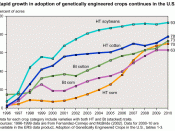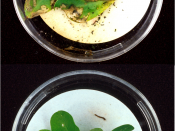Genetic EngineeringThroughout history, there have been many issues over genetically engineering our food that we eat on an everyday basis. World exploration did not exist until the 1500s because the world was thought to be flat. History shows us that technology is not a bad thing, but a way to make life easier. Genetic engineering is one of these ways. Genetic Engineering is capable of producing crops in third-world countries for literally pennies, curing serious genetic flaws in people, or even before they are born. Genetic engineering is a science that will be a standard in the future. The FDA and the government seem to be holding back the research of Genetic engineered food. This will only lead to unsafe gene modification, causing even more problems with human health.
Genetic engineering has the potential to create new products far better than anything we have ever thought capable. Detergents could be made from enzymes that work far better in cold water than existing products.
Color pigments that don't fade in heat could be made from microbes that thrive in hot water. Even, antibiotics that are strong enough to kill even the most drug resistant bacteria. Genetic engineering is also extremely important to forensic science field. Advances in DNA mapping insure that if any skin flake, blood drop or hair strand is found at the scene of the crime, the forensic scientists can determine who it belongs to. The possibilities are now endless on what humans can create. We can even create such things as transgenic animals. ÃÂGenes from the hardy llama in South America, for example, could be introduced into camels in theMiddle East and vice versa to greatly expand the range of eachÃÂ according to, Tamara Roleff. This would enhance both animalsÃÂ abilities to thrive in harsh climate conditions.
Something that most people donÃÂt realize is that plants are heavily depending on us. But soon plants might not have to worry as much since the genes of plants are being altered constantly. For example, tomatoes are sensitive to frost. This shortens their growing season. Fish, on the other hand, survive in very cold water. Scientists identified a particular gene which enables fish to resist the coldest temperatures in water and used the technology of genetic engineering to insert an anti-freezing gene into a tomato. This makes it possible to extend the growing season of the tomato and increasing the possibilities of survival on the tomato. People would think this is a good thing but for every positive change, their must be a downside also. For example, Insects, birds, and wind can carry genetically altered seeds into neighboring farmerÃÂs fields. Pollen from transgenic plants can cross-pollinate with genetically natural crops. All crops, organic and non-organic would be vulnerable to contamination from this cross-pollination. And this threatens our entire food supply.
There is even more danger for example, Genetic engineers uses antibiotic-resistance genes to mark genetically engineered cells. This means that genetically engineered crops contain genes which are resistance to antibiotics. These genes may be picked up by bacteria causing humans to possibly become affected. There is a lot to risks. Since scientist think only in increasing food growth, they forget who is more important, the consumers.
Risk assessments are done on Genetic Engineered foods that come into circulation with the United States. But these risk assessments can be very complicated. Because even rigorous assessments involve numerous assumptions and judgment calls. These assumptions and judgment calls are often controversial when they are used to support particular government decisions. For example, the approval of the first genetically engineered squash by the United States Department of Agriculture involved a controversial risk assessment. It took months before they decided to release the squash into our food markets. But since then hundreds of Genetically Engineered foods have been approved.
A lot of farmers have problems with crop damage mainly do to insects. Also viruses, bacteria, and rodents also take part in destroying crops. With gene splicing, these problems can be removed from a farmer's life completely. A good example is Genetically engineered corn. This is a result of a bacterial gene that has been inserted into a corn plant. The result is a protein that is lethal to cornÃÂs pests, as well as a few other insects, but not to mammals. As it repels insects, the gene-spliced corn also lowers the levels of fumonisin, a dangerous fungal toxin that can lead to fatal diseases in horses and swine, and esophageal cancer in humans. Over three years ago, gene splicing biologists at the Australian National University unexpectedly transformed a rodent disease mousepox into a highly lethal pathogen that kills 60% of infected mice, even those immune to the original virus. American researchers continued that research and produced a similar virus that is nearly 100% fatal. If this or any similar virus is approved by FDA and used all over the U.S., it is expected to reduce pest related crop loss by 66% in 2025 (Roleff).
The negative effects of transgenic plants on ecosystems have also presented scientists with a new problem to solve. One of the problems is, finding a way to suppress pollen dispersal in transgenic crops. Scientists are currently cultivating sterile male corn plants as a prototype for all other transgenic plants that disperse pollen over wide ranges (Losey). When this is achieved, the overall cultivation of transgenic crops becomes more expensive and time consuming and many farmers will be required to plant new crops year after year instead of allowing their plants to simply reproduce naturally.
Genetic farming is also a huge benefit that genetic engineering will bring. Scientists are testing crops that would produce blood thinners and insulin, at a very cheap cost. The materials for these drugs come from plants themselves, water, and carbon dioxide. Most animals, including humans, can't make their own omega-3s, which are building blocks of fat that seem to protect against heart attacks. (Weintraub)A group of scientists at Harvard University altered the genetic code of mice, inserting a worm gene that converts more common fats into omega-3s. The result was a success. The mice generated their own omega-3s from a diet poor in this nutrition. Jing Kang, a member of the group, believes that this technique could also work in livestock. After being asked if humans could create their own omega-3s, Kang responded, "It's possible, but that would depend on the progress of gene therapy in the future". The Swiss Federal Institute of Technology for Plant Sciences has had similar stories of success. The scientists at the Swiss Federal Institute of Technology for Plant Sciences have announced they have genetically improved two new rice strains designed to "combat nutritional deficiencies" (Miller). The edible portion of rice, the endosperm, lacks nearly all vitalnutritional elements, like Vitamin A and iron. This affects billons of people in countries where rice is a staple food. The new varieties increase the amount of beta carotene, which is metabolized in the body to Vitamin A (Miller).
Genetic engineering of crops have come a long way since the first hunters and gatherers realized the positive effects of dominant plant traits. Medicines and vaccines are being produced that might help cure every human on this earth. Who knows what else we might stumble upon? Humans may be consuming their flu vaccines at the dinner table someday. However, when experimenting with these crops that are essential to us, it is important that we assess both the positive and negative effects on these changes in crops, not only for us, but for future generations to whom this plant will consist of and thrive upon.
Works CitedÃÂMiller, Henry. "The Biotech Baby Food Scare." Consumers' Research Magazine 10/01/99: 12ÃÂWeintraub, Pamela. Audubon. New York: Jul 1992. Vol. 94, Iss. 4ÃÂRoleff, Tamara L. What Ethics Should Guide Genetic Research? Greenhaven Press, Inc. 1998ÃÂLosey JE, Rayor LS, Carter ME. 1999. Transgenic pollen harms monarch larvae. Nature 399: 214ÃÂhttp://www.genomenewsnetwork.org/articles/05_00/antibiotic_resistance.shtmlÃÂhttp://www.wvu.edu/~agexten/ipm/animals/genetic2.htmÃÂTurner, Lisa. Better Nutrition. Atlanta: Apr 2007. Vol. 69, Iss. 4


